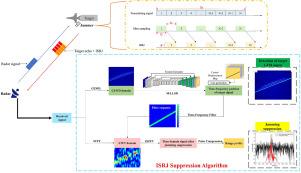Anti-interrupted sampling repeater jamming via linear canonical Wigner distribution lightweight LFM detection
IF 3.6
2区 工程技术
Q2 ENGINEERING, ELECTRICAL & ELECTRONIC
引用次数: 0
Abstract
Interrupted sampling repeater jamming (ISRJ) poses a serious threat to radar target detection. Traditional time-frequency (TF) domain anti-jamming methods are prone to TF aliasing in multi-component signal scenarios, and cannot effectively suppress ISRJ with energy close to the real target under low signal-to-noise ratio (SNR) conditions. To address these challenges, this paper proposes an anti-jamming method based on generalized linear canonical Wigner distribution (GLWD) line detection. By setting the parameters reasonably, the TF image of GLWD can have excellent TF resolution and energy concentration, greatly improving the signal separation and SNR. Furthermore, in order to enhance the detection capability of the target LFM signal, the existing mobile line segment detection (M-LSD) is improved and the mobile long line segment detection (M-LLSD) is proposed. M-LLSD can detect the target signal more easily and reduce the sensitivity to the jamming signal, so as to efficiently and accurately extract the TF position information of the target signal. Finally, a TF filter is constructed based on the mapping between GLWD and short-time Fourier transform (STFT), performing filtering in the STFT domain to suppress jamming. Simulations and experiments show that the method can effectively suppress such difficult-to-distinguish jamming and is suitable for real-time radar anti-jamming with good robustness.

基于线性正则维格纳分布轻量LFM检测的抗干扰采样中继器
中断采样中继器干扰(ISRJ)对雷达目标探测构成严重威胁。传统的时频域抗干扰方法在多分量信号场景下容易出现时频域混叠,在低信噪比条件下无法有效抑制能量接近真实目标的ISRJ。为了解决这些问题,本文提出了一种基于广义线性正则维格纳分布(GLWD)线检测的抗干扰方法。通过合理设置参数,GLWD的TF图像具有优异的TF分辨率和能量集中度,极大地提高了信号分离度和信噪比。在此基础上,对现有的移动线段检测(M-LSD)进行了改进,提出了移动长线段检测(M-LLSD)方法,提高了对目标LFM信号的检测能力。M-LLSD可以更容易地检测到目标信号,降低对干扰信号的灵敏度,从而高效准确地提取目标信号的TF位置信息。最后,基于GLWD和短时傅里叶变换(STFT)之间的映射构造TF滤波器,在STFT域中进行滤波以抑制干扰。仿真和实验表明,该方法能有效抑制这种难以分辨的干扰,适用于雷达实时抗干扰,具有较好的鲁棒性。
本文章由计算机程序翻译,如有差异,请以英文原文为准。
求助全文
约1分钟内获得全文
求助全文
来源期刊

Signal Processing
工程技术-工程:电子与电气
CiteScore
9.20
自引率
9.10%
发文量
309
审稿时长
41 days
期刊介绍:
Signal Processing incorporates all aspects of the theory and practice of signal processing. It features original research work, tutorial and review articles, and accounts of practical developments. It is intended for a rapid dissemination of knowledge and experience to engineers and scientists working in the research, development or practical application of signal processing.
Subject areas covered by the journal include: Signal Theory; Stochastic Processes; Detection and Estimation; Spectral Analysis; Filtering; Signal Processing Systems; Software Developments; Image Processing; Pattern Recognition; Optical Signal Processing; Digital Signal Processing; Multi-dimensional Signal Processing; Communication Signal Processing; Biomedical Signal Processing; Geophysical and Astrophysical Signal Processing; Earth Resources Signal Processing; Acoustic and Vibration Signal Processing; Data Processing; Remote Sensing; Signal Processing Technology; Radar Signal Processing; Sonar Signal Processing; Industrial Applications; New Applications.
 求助内容:
求助内容: 应助结果提醒方式:
应助结果提醒方式:


